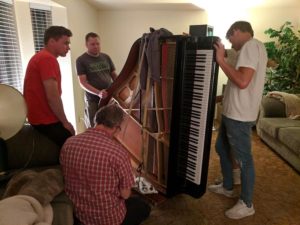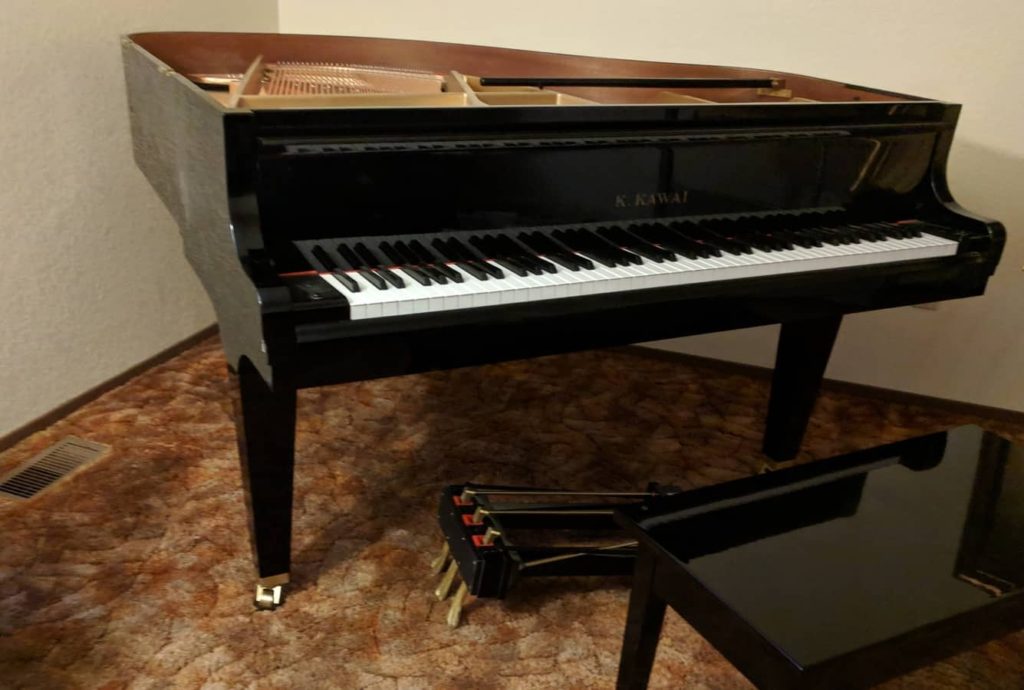Moving a piano is no easy task. With the investment you have put into your instrument, you don’t want to do anything to risk damaging the piano, especially during the move. When moving our piano, I wanted to make sure we were safe to move it on its side to help get it around corners, so I called up a piano moving company just to make sure.
Can you move a piano on its back or side? Moving a piano on its back or on its side does not harm a piano. A piano can be moved, tilted, or rotated without doing it damage. Damage to a piano occurs when it is dropped, or bumped, or when foreign objects are inside the piano when moving.
Moving a piano takes preparation to avoid damage. Follow these suggestions before you begin the move.



How to Avoid Damage to the Piano
If you are worried about any damage at all, then don’t take the risk of damage to your piano and call professional piano movers. They will know exactly what to do to keep your piano from becoming damaged.
Most piano are moved by tilting it — especially grand pianos. They are carefully lifted and transported securely. Although you can move a piano on its side or back when moving, it’s not suggested to keep it that way for any longer than you need to. So keep your pianos upright if you can, especially when transporting it.
Check inside the piano to make sure that there are no foreign objects such as hair pins, pennies or loose coins, or pens inside. If these are inside, they can get lodged in places that will do that piano damage. They can also affect the hammers and strings if they are bouncing around throughout the move.
Cover any area of the piano that will come in contact with another object, such as a dolly. Drape a blanket over it before you tilt it back onto the dolly. This will help to avoid unintended scratches or dents.
Tightly secure the piano when moving with ratchet straps long enough to wrap the piano. If it has any possibility of sliding or adjusting when transported, then it will likely cause damage to the finish of the piano at the very least. It is better to be overly cautious than not enough so use that extra strap if you have it.
Pianos are most damaged when they are dropped, or unexpectedly slide. Don’t underestimate the weight of the piano and what it will take to get it to its destination. Always overestimate on manpower. It took five men to move our baby grand.
Ensure that you have what you need to get a piano to its destination safely, such as a piano dolly, blankets or padding to protect the piano, ratchet straps long enough to go around the piano, and a trailer or u-haul (a pickup truck would be too tall to lift into).
Do not roll a piano on its rollers. The rollers on a piano are to make small adjustments. Do not rely on them to move the piano. The legs on an upright piano with rollers do not hold up to moving the piano when used. Many pianos have been damaged by assuming one can just push on the piano without easing the weight on those legs. It is suggested removing the legs altogether to avoid damage. Use a piano dolly to roll it around.
Consider wrapping blankets or padding around corners or stairways. Take a look at the path your piano will take and consider taking precautions to avoid the piano (and your house) by padding areas that could be potentially harmful.
Move anything (including furniture) out of the way in order to make the move easier.
Protect the pedals by wrapping them in a blanket or towel and taping it securely. Piano pedals are another item that is likely to become damaged in a move, so take the precautions needed to protect them. You can also unscrew and take off the top of the grand piano and secure that separately.
If you are moving a piano outdoors, make sure to wrap some plastic around the piano. Sun or rain can cause damage to the piano. You certainly want to be extra careful of moisture. Moisture is not good for pianos and can cause a piano expensive repairs.
If your piano weighs over 1000 pounds (such as a grand piano) then it is highly suggested to hire a piano mover. The weight of that instrument needs professionals to avoid any damage. The cost of your instrument that you are protecting is worth the cost of the move.
If you are looking to level up your piano, check out our very own Learn with Pianotels course, designed with 17 years of experience and proving to be not only a blast, but students are excelling 8-10x faster than they were before. Learn with Pianotels is affordable for the whole family and it is unique in having video chats available at any time.

How to Avoid Injury to the People Moving the Piano
Pianos weigh hundreds of pounds. Do not recklessly move a piano at the cost of hurting someone. As mentioned earlier, always overestimate the amount of people you will need to help move a piano.
Move a piano by lifting with the feet. Do not use your back to lift. Bend at the knees and lift straight up before moving in any direction.
Have a plan. Each person involved in the move needs to make sure that they are aware of the plan so that the movers can work in unison.
Don’t ever catch a falling piano! The momentum of a falling piano can cause serious injury. If a piano happens to fall, do not try to catch it.
Take breaks. If anybody is in need of a break, make sure to pause. A piano should be moved slowly, both for the sake of the piano and for the sake of the movers. If someone does need a break, everyone will need to put the piano down at the same time to avoid someone carrying too much weight at once.
Be aware of what you are wearing to avoid anything get caught on your clothing. Not only do you want to avoid being distracted, you want to make sure that you won’t impede the move due to baggy clothing that gets snatched.
Ways to Transport a Piano
Consider all your options of moving your piano to make sure you come up with the best option.
Call a piano mover. There are professionals out there who really know what they are doing. They have done it many times and they know the best ways to safely move the piano without causing damage to your house.
Use a piano dolly. A piano dolly is flat with wheels underneath. A good dolly (check out a piano dolly here) will have some grip on it to keep the piano on it without falling off. You definitely don’t want to have a piano on a dolly that will immediately slide off when you push its, so something grippy is important.
Use a ramp for stairs. If a few stairs are in the path, consider using a solid ramp that can be used for getting up or down the stairs.
Rent a moving truck. Even if you have a pickup, getting it up and over the tailgate is a problem. If you rent a moving truck, the lift is much smaller and often times they have a ramp to walk up so that the piano can be rolled up on its dolly. Strap it in to the side of the u-haul to make sure it stays securely for the drive.
Measure it out and plan your route. Make sure you are aware of the exact path of the piano. Measure the piano and measure the space you want to fit it through. Make sure it will fit before attempting to move it. You will also want to be aware of the weight of the piano (can range from 400-1200lbs) before you take it across a floor or down stairs that can’t hold that weight in addition to the bodies that will be carrying it.
Tune Your Piano After Moving It
Even if you move your piano across the room, every piano needs to be tuned once you move it.
Once you do move a piano, let it settle for about 3 weeks before you call the piano tuner. The piano will need some time to settle into its new environment. Even if you have it tuned immediately, it will not stay in tune. That’s why they suggest waiting to tune the piano for a few weeks before you tune it.
Moving Electric Pianos
Electric pianos are often made for transportation, but caution is still advisable. Treat them with care. Pick them up and set them down gently. Make sure they are in a stable location before you leave the piano to avoid it falling over. Carelessness can lead to accidents that will damage your piano. Also be aware of other people. Avoid high traffic areas that could cause the piano to be bumped.
Related Questions:
What does it cost to move a piano? A piano mover can cost as low as $100 and as much as $500 or more depending on the instrument and the length of the move. Call a piano mover and get a free quote to find out what your piano will cost to move.
How much does an upright piano weigh? An upright piano weighs around 400 pounds. Grand pianos weigh around 1000 pounds, depending on the length of the piano. Baby grand pianos can weigh between 500-800 pounds.
Tel loves her life as a piano player, a piano teacher, and a mom. Amid piano blogging, piano teaching, and piano playing, she loves a chance to fit in a good exercise class, volunteer at her kids’ school and at her church, and go on long dates with her husband. Full bio at About Tel.





Such a great post! I really enjoyed reading. Also, one of the most important things here is if the piano needs to be stored, always have in mind that the piano needs to be in a safe environment, such as climate-controlled storage that regulates the temperature and protects your piano from the damaging elements.
Good point! Thanks for sharing!
This is a crazy post. First and foremost, call a professional piano mover to move a valuable upright or grand piano. Don not think for a moment that a DIY move is a good idea. The photos show many of the “Don’ts” for piano moving. What has the lid been removed from the grand piano, top phot? Where are the pads? Why is the keyboard cover open? Don’t any of these guys think wearing a back brace is a good idea? Where is the grand board or dolly? Just crazy, crazy to post this.
All good points to consider! If you feel uncomfortable with moving your piano, then call a professional mover! When this piano was moved, caution was taken but obviously some risk was involved. Make sure you take all those things into consideration when moving a piano! We did use pads, loose parts of the piano was taken off to avoid damage, and a dolly was definitely in use as well when we moved it. Please take appropriate caution when moving your piano as well!
My husband and I are going to be moving soon, and we are trying to figure out how to best get our piano to our new home. Thanks for pointing out that it’s smart to hire professionals since they have experience with that kind of stuff, and will know how to move it without damaging anything. Since I wouldn’t want to damage our brand new home or our piano, I’ll have to start looking into movers that can help us get the job done safely and efficiently.
Great Post about moving a Piano. Thanks for sharing.
It helps a lot when you mention how professional piano movers have the experience needed to safely transport your piano while minimizing property damages. My wife and I recently inherited my late aunt’s grand piano and need to find a way to lift it out of the basement so that we can take it to our new home this month. We’ll find someone that can assist us soon.
Great Post. Thanks for sharing.
“OZ Removalists is one of the best moving company in Melbourne. I used their piano removal service, and I had a great experience working with them. They do their work perfectly.”
It isn’t a good idea at all to move a piano on either its back or side when moving it. I think that something like this can potentially destroy the piano.
It would help if you never moved a piano yourself. Always hire a professional to do this because moving a piano isn’t an easy thing to do at all.